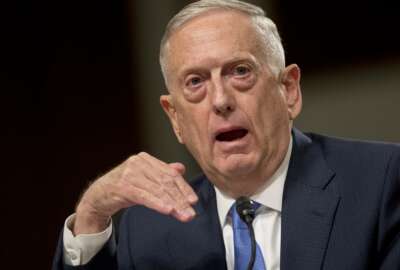
Trump faces royal flush of opposition from defense committee leaders to using military construction funds for wall
All four leaders of the Armed Services Committees oppose using military construction funds for a border wall.
Best listening experience is on Chrome, Firefox or Safari. Subscribe to Federal Drive’s daily audio interviews on Apple Podcasts or PodcastOne.
Another top lawmaker is opposing the use of military construction funds to build a wall on the southern border.
The announcement comes as congressional negotiators near a spending deal to avert another partial government shutdown. The deal comes in far lower than the $5.7 billion requested by President Donald Trump for the wall.
Senate Armed Services Committee Chairman Jim Inhofe (R-Okla.) is the latest of the “big four” running the armed services committees to oppose dipping into military construction funds if Trump declares a national emergency to build the wall.
“If it becomes necessary, I think Trump might use the emergency,” Inhofe told reporters Tuesday at the Capitol. “I don’t want anything to degrade military construction.”
But Inhofe did break with other committee leaders in that he said he will accept diverting Army Corps of Engineers funding to go toward the wall.
“It’s a matter of prioritizing,” Inhofe said. “Any time you are faced with two bad choices; one is worse.”
House Armed Services Committee Chairman Adam Smith (D-Wash.), Ranking Member Mac Thornberry (R-Texas) and Senate Armed Services Committee Ranking Member Jack Reed (D-R.I.) all previously said they are against using military construction funds for a border wall.
The use of military construction funds comes from Trump’s threat to declare a national emergency at the southern border to build the wall if Congress refuses to pay for it.
Enacting a national emergency allows the president to use unobligated military construction funds and possibly counter-narcotics funds to build infrastructure needed to secure the country.
It also allows the White House to halt Army civil works projects and apply those funds and resources to national defense projects.
There is currently $16.4 billion unobligated in the 2018 military construction budget, according to DoD’s 2018 financial statement. The executive could theoretically access those defense funds without congressional approval under a national emergency.
Opposition to dipping into military construction comes mostly from concern for military installations.
“Last fall, I vividly remember touring a barracks with mold growing out of the ceiling where they had to evacuate the soldiers out of certain rooms,” Thornberry said last month. “We went over to see a repair facility where it was from the 1950s, where they couldn’t repair some of the vehicles indoors because it was so old. As the defense budget was cut, military construction was devastated and as much as we’ve done the last two years, we have not made up for that deficit.”
Thornberry isn’t alone in his concern for military infrastructure. Multiple military installations officials testified before Congress that military infrastructure is failing. About 20 percent of DoD facilities are in failing condition. The Army alone needs $11 billion to get its facilities and installations in working order.
The Government Accountability Office regularly finds issues with military facilities.
“Service members we spoke with described poor conditions at some facilities, including heating and cooling system problems, leaking roofs and windows, and mold and mildew,” a 2018 GAO blog said.
Reed also feared for military installations.
“The Pentagon has billions of dollars in infrastructure backlogs, ranging from military construction projects for new missions to deferred maintenance in facilities sustainment, restoration and modernization,” Reed said in a statement on Jan. 4. “There is no credible argument that a border wall takes priority over any of these. Moreover, if President Trump attempted to use [military construction funds], that would require the Defense Department to cancel military construction projects that have already been authorized and appropriated by Congress in order to try and redirect the funds to a border wall.”
Last night, Congress reached a tentative deal that would give nearly $1.4 billion to border security and fund 55 miles of new fence along the border.
Budget plans
While lawmakers are trying to figure out some of the funding for 2019, the defense committees are beginning to look forward to 2020.
DoD is already going to be a month late in sending its budget over to Congress.
Inhofe said he supports a $750 billion budget and is willing to do anything necessary to get there. There are multiple reports that DoD may stuff its emergency war fund, so it can reach the funding it needs without breaching the budget caps.
Inhofe said he would be amenable to the idea if no other option was available. Inhofe said what is most important to him is that DoD gets a $750 billion budget in 2020.
He added that despite the delay in budgeting, the Senate Armed Services Committee plans to stay on schedule and finish the 2020 defense authorization act in June.
Copyright © 2025 Federal News Network. All rights reserved. This website is not intended for users located within the European Economic Area.
Scott Maucione is a defense reporter for Federal News Network and reports on human capital, workforce and the Defense Department at-large.
Follow @smaucioneWFED
Related Stories





